
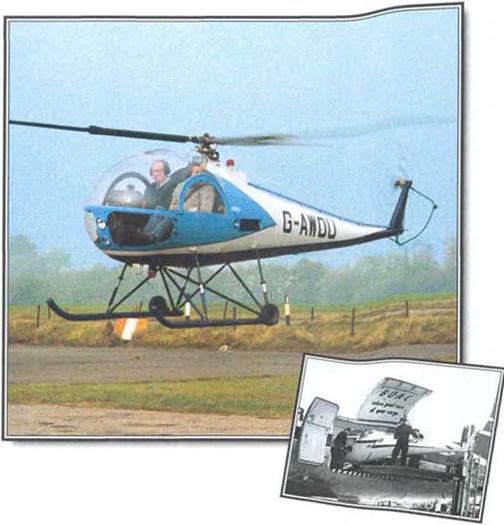 n 1946 the first of Brantly’s helicopter
n 1946 the first of Brantly’s helicopter
 designs, the over-complex B-1, flew for the first time. Undaunted by the unpopularity of his initial design, Brantly went on to produce the best-selling B-2. Through at least three changes of company ownership, the B-2 remained in constant production, a testimony to the soundness of the basic design. Constant improvements allowed the type to remain in production from 1958 until 1994.
designs, the over-complex B-1, flew for the first time. Undaunted by the unpopularity of his initial design, Brantly went on to produce the best-selling B-2. Through at least three changes of company ownership, the B-2 remained in constant production, a testimony to the soundness of the basic design. Constant improvements allowed the type to remain in production from 1958 until 1994.
|
|
|
A Model 305
Basically an onlarged B-2. theXR was potentially a more versatile design, but did not sell well.
|
|
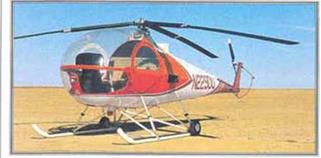

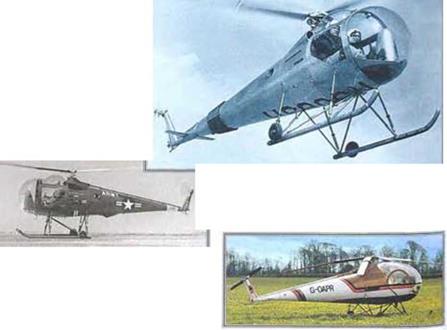
A Attractive presentation
Finished m a bright colour scheme, the Brantly B-2 is an attractive and sleek-hoking helicopter. Several examples remain in regular servico.
Unchanging design у
This early B-2A demonstrates the original lines of the typo and how little they wore fo change dunng three decades of production.
A Army evaluation
Five B-2s were tested by the US Army under the designation YHO-3-BR. No production order resulted from this evaluation and tho B-2 also failed to win orders from the British Army.
▼ In the business
This immaculate B-2B is seen under the ownership of Helicopter International Magazine.
FACTS AND FIGURES
► When Brantly was taken over by Hynes, tho B-2 becamo tho Brantly-Hynes B-2. It continued in production until 1994.
► Brantly also developed the 305, a larger, five-seat helicopter based on tho B-2.
Float, skid or wheeled landing gear was an option on all B-2s.
► James T. Kirnurn was tho third owner of the B-2 type certificate, and delivered he* first B-2B on 25 August 1990,
>• British Executive Air Services acquired a production licence for tho B-2.
> In 1992, a B-2B cost US$120.000 to US$135,000 depending on equipment fit-
|
|
|
B-2B
Type: I wo-beat light helicopter
Powcrplant: one 134-kW H80-«p. l Textron Lycoming п/О-360-AiA flat-four piston engine
Max speed: ’61 km/h (100 ntpA) at sna lovel
Max cruising speed: 145 km/h (90 m. p h.) at 75 per cent power
Initial climb rale: 590 m’rmn (t.900 f. p.m i at sea level
Range: – too km (250 mi.) With maximum fur – and roiwrvor.
|
|
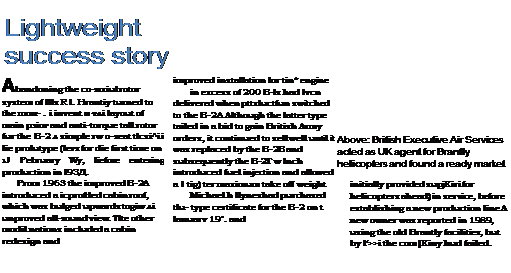 |
|
Bolow: A choice of undercarriage gave the B-2 added flexibility. These floats soom overly large for such a small machine, however, and must have roducod performance dramatically.
|
|
|
Service ceiling: 3290 rr. іп. оос ft i
Weights: empty 463 kg (1.020 lb) (with sk-ds): maximum take-off 757 kg (1.665 lb )
|
|
|
Dimensions:
main rotor diameter fuselage length height
main rotor dec area
|
|
|
7.24 m (23 ft. 9 in.) 6.62 m |21 ft 9 m| 2.05 m (6 ft 9 in.) 41 16 m – (443 sq ft.)
|
|
|
|
|
Eacn man rotor bade s n two зесЬсжтз. the oulbotro twit detach^ for o:rv, уггл-эде m confined spacos A srantess stool wutWig edge atop о fitted to the ncn romovablo section,
|
|
|
A compart тот.: о the forward port ol the tailcone pro-ados «расо for n uvixutium of 227 kg |5Q lb.| of boggayo. Tire tnakos I ho 0 ? a iiaohrl lotirvig mnchria
|
|
|
With 11» mfrooucticn oi UAjed yvi/rnj f»-o В-2Л and В ргемаеа a ivurji better afc-round van sorr.
|
|
 |
|
The fuselage ‘i Of Stool tutio – jlructum іхЛ Uvi talcono is of ai чгю*и guessed skn construction Tho looocxl tailnKW also provides projection lor If» tal rotor when the aitcralt m По-лп r. ro tght soaoes
|
|
|
surfaces. This зяггаИ « asо fitind wild ground-nandbig w«u»s Oinor lancing peer optens are Hoots я ake.
|
|
 |
|
I 8ELL 47: One of the earliest product*» helicopters, having been produced from 1946. the Model 47 wits still in production during the 1960s. Many hundreds were built
|
|
|
■ ENSTROM F-28: Having or. fored production during the autumn of 1963. tho F-23 was intended to offer exceptional value for a throe – seat lightweight hnlcoplnr

|
|
|
■ HUGHES 269: Hughes found a very successful formula with its mthor ungainty – looking l. fodcl 269. Hundreds of aroralt were built in the US and under licence.
|
|




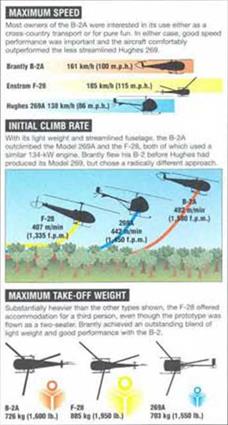

Bristol
![]()
 n 1946 the first of Brantly’s helicopter
n 1946 the first of Brantly’s helicopter designs, the over-complex B-1, flew for the first time. Undaunted by the unpopularity of his initial design, Brantly went on to produce the best-selling B-2. Through at least three changes of company ownership, the B-2 remained in constant production, a testimony to the soundness of the basic design. Constant improvements allowed the type to remain in production from 1958 until 1994.
designs, the over-complex B-1, flew for the first time. Undaunted by the unpopularity of his initial design, Brantly went on to produce the best-selling B-2. Through at least three changes of company ownership, the B-2 remained in constant production, a testimony to the soundness of the basic design. Constant improvements allowed the type to remain in production from 1958 until 1994.






















